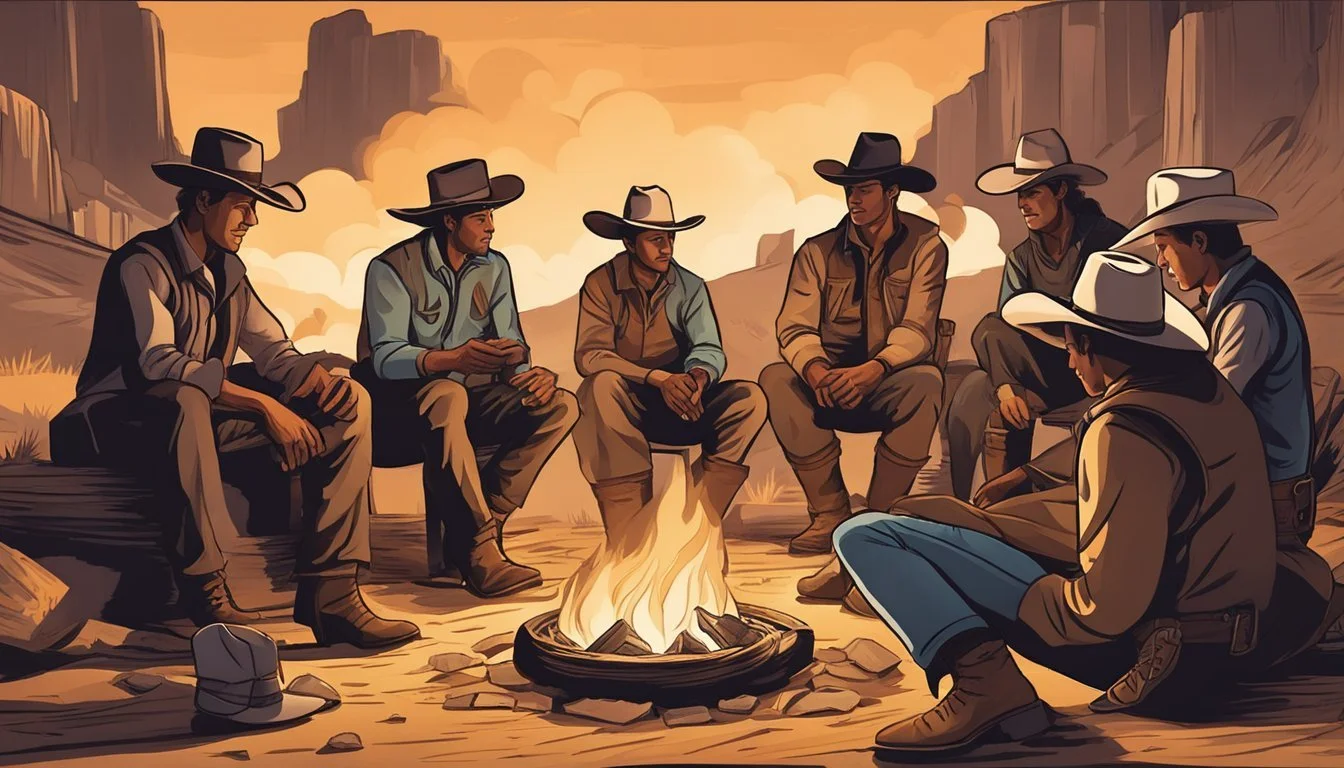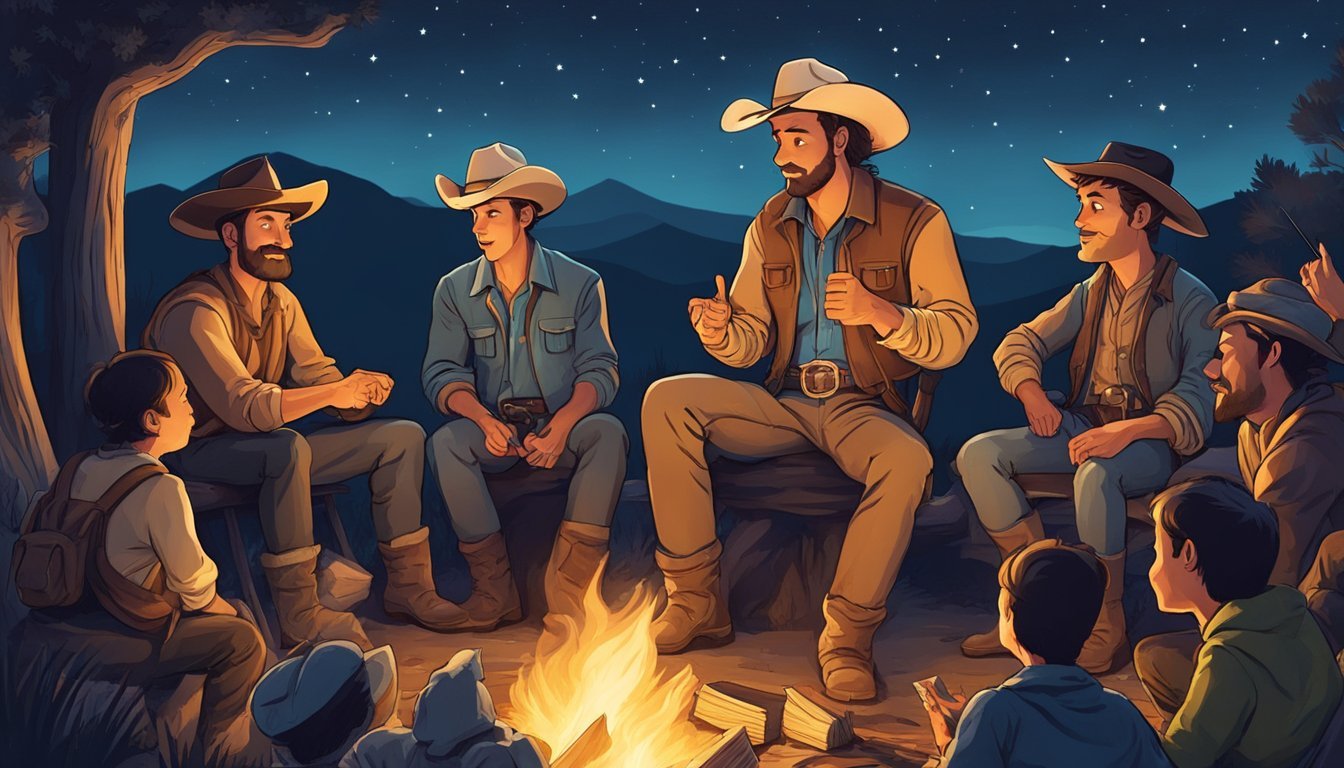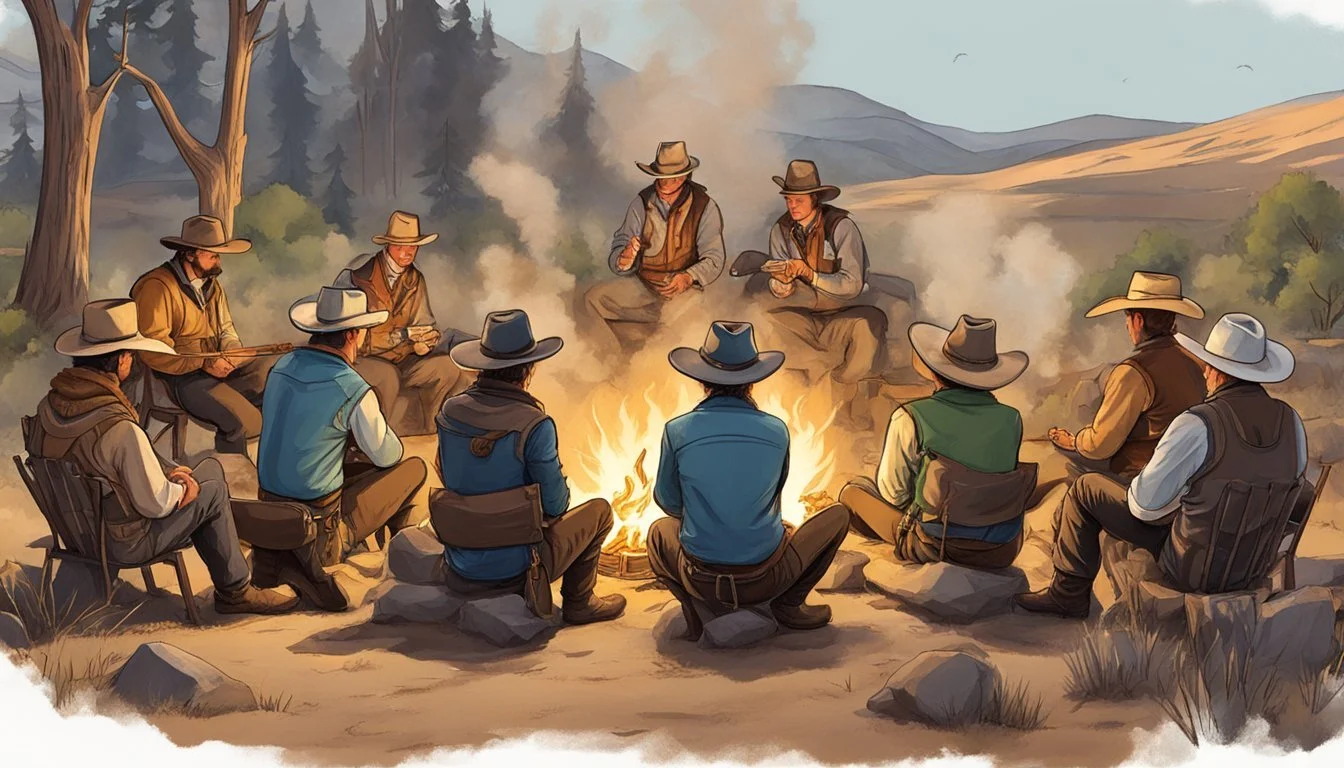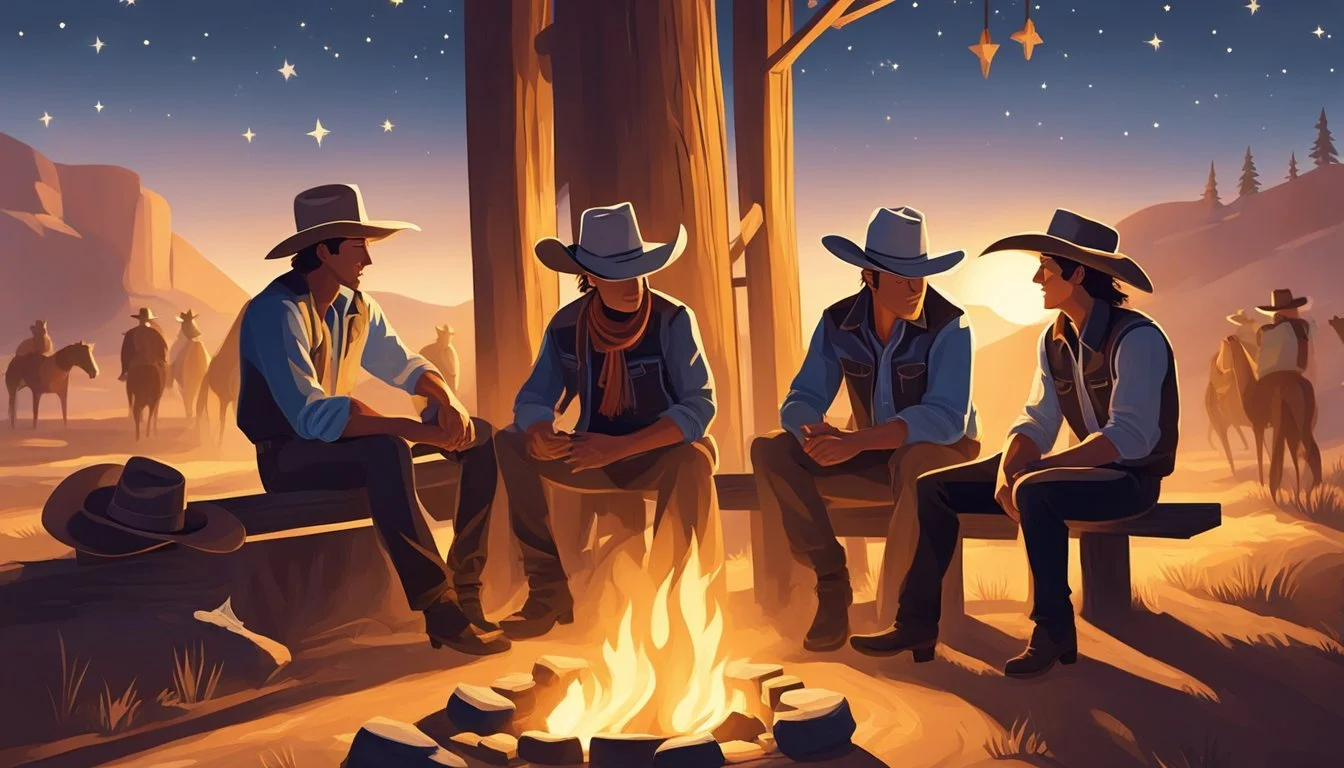The Tradition of Cowboy Storytelling Around the Campfire
An American Legacy
The tradition of cowboy storytelling, practiced around the flickering flames of a campfire, has deep roots in American history. It was an art form that blended entertainment and culture during a time when cowboys spent long, arduous days on the trail. At night, these open ranges transformed into stages for oral storytelling, where cowboys would gather to unwind. The campfire provided not just warmth and light but also became a centerpiece for bonding and sharing tales that ranged from personal experiences to mythical folklore.
Campfire stories played a crucial role in preserving the history and legends of the Old West. Without the benefit of modern technologies, storytelling by cowboys was a key means of communication and a method to pass along valuable lessons and morals. These narratives often featured elements of the supernatural, adventure or humor, and occasionally, lessons learned from the hardships of frontier life.
The tradition also showcased the artistic abilities of cowboys as storytellers. They learned to captivate their audiences through vivid descriptions and dramatic pacing, holding their fellow cowboys' attention after a day's hard work. While the art of cowboy campfire storytelling has evolved over time, its essence remains an important part of America’s cultural heritage, encapsulating the spirit of freedom and adventure that defined the cowboy era.
The Birth of Cowboy Storytelling
At its core, the birth of cowboy storytelling reflects a rich confluence of histories and traditions that emerged around campfires during the long cattle drives of the 19th century. The narratives spun by cowboys were as diverse as their origins, encapsulating both the hardships and adventures of the cowboy life.
Historical Origins
The American cowboy storytelling tradition started during the era of long-distance cattle drives from Texas to railheads in Kansas, post-Civil War. These drives required cowboys to spend lengthy periods away from home, and storytelling became a vital medium for entertaining one another during these times. The tales and poems shared around the campfire were not only a form of entertainment but also a means to preserve history, convey social norms, and reinforce the shared values of their closely knit community.
Cowboy stories often consist of personal experiences, legend-like embellishments of actual events, and accounts of day-to-day activities that resonated with the cowboy’s lifestyle. They are a product of the environment in which they were told—a rugged, often isolated life that necessitated a strong camaraderie among cowboys.
Influence of the Vaquero and Gaucho Traditions
The cowboy tradition of storytelling is deeply influenced by earlier herding cultures, most notably by those of the vaquero of Mexico and the gaucho of Argentina. The vaquero, recognized as the first cowboys of the Americas, possessed a rich oral culture that comprised stories and songs about the land, the animals, and their experiences on the range.
Likewise, the gaucho contributed a storytelling style imbued with their experiences on the vast pampas and their lives as master horsemen and cattle herders. The interactions between American cowboys and these predecessors led to a blending of cultural elements, which included storytelling traditions and practices.
This cross-cultural exchange enriched cowboy stories, blending the practical, day-to-day oral traditions of the herding cultures with the American cowboys' own narratives, creating a distinct storytelling tradition that is part literary creation, part folk history.
Cowboy Storytelling as an Art Form
Cowboy storytelling, an intricate tapestry of art, language, and imagination, embodies the heart of cowboy culture. This art form thrives around the warmth of a campfire, where tales are woven with vivid imagination and the rich texture of language.
Elements of a Good Campfire Story
The essence of a captivating campfire story lies in its ability to transport listeners to another time and place. Storytellers rely on a few key components:
Relatable Characters: Often featuring rugged cowboys, these characters embody the spirit of the Wild West.
Engaging Plot: The narrative arc typically involves adventure, conflict, and resolution, holding listeners' attention.
Supernatural or Legend: Folkloric elements or slices of local legend enrich stories with mystery and depth.
Sensory Details: Vivid imagery and descriptive language engage the senses, painting a scene as vast as the prairie itself.
Role of Imagination and Language
Imagination fuels the fire of storytelling, with each tale spun from the threads of the impossible and the everyday. Language is the cowboy storyteller's paintbrush, a tool to craft scenes and emotions that resonate deeply with their audience. Storytellers engage in a deliberate choice of words and pacing, harnessing:
Vivid Descriptors: Strong, clear descriptions bring the story to life.
Rhythmic Cadences: The natural rhythm of speech mimics the cadence of a horse's trot, a stylistic echo of the cowboy's daily life.
Cultural References: References to cowboy life and the Western landscape provide authenticity and context.
Common Themes and Content
In the luminescent glow of campfires, cowboy storytelling taps into vibrant themes that reflect the vastness of the American West and the human spirit. It often evokes a sense of awe with heroes battling against supernatural elements and nature itself.
The American West and Nature
The stories told are frequently imbued with the spirit of the American West, an expanse synonymous with adventure and the untamed wilderness. They paint a vivid picture of life on the open range, highlighting the beauty and severity of the natural world. Characters in these tales are often set against backdrops of majestic mountains, endless deserts, and untamed rivers, reflecting the environments they traverse.
Key Elements:
Vast landscapes
Extreme weather
Interaction with native flora and fauna
Cowboys, as custodians of this sprawling natural world, share their experiences through tales that may involve harmonious encounters or fierce battles with the animals of the West such as wolves, horses, and buffalo.
Heroes, Fear, and the Supernatural
Cowboy stories are rife with themes of heroism, where the protagonists confront their fears, often personified by supernatural threats. These antagonists—be it ghosts, spirits or creatures of folk tales—serve to test the mettle of the cowboy heroes.
Elements of Fear and the Supernatural:
Ghost stories of haunted prairies
Folklore of spirits and mythical beasts
Personal tales of survival against the odds
The narratives typically celebrate individual courage and communal spirit, resonating with the listener's innate fear, while simultaneously offering a glimpse into the supernatural aspects that have filled the imaginations of those who have lived and worked in the vast expanse of the West.
Cultural Significance and Preservation
The storytelling tradition of cowboys around the campfire is not only a celebrated aspect of American West folklore, but also a practice deeply rooted in cultural preservation and the sharing of beliefs through oral traditions.
Storytelling Across Cultures and Ages
Throughout history, diverse cultures have used storytelling as a means to convey important information, moral lessons, and communal values. Cowboys, with their long treks and communal life on the range, developed a rich oral storytelling tradition around their campfires. Similarly, storytelling traditions are seen globally from the vaqueros of Latin America to the nomadic herders of the African savannahs. These stories often carry the weight of generations and are an essential part of cultural preservation, allowing societies to maintain a sense of continuity despite the passage of time.
Folklore and Oral Storytelling Traditions
Cowboy storytelling is rooted in folklore, comprising myths, legends, and tall tales that reflect the values and experiences of the cowboy lifestyle. Oral storytelling is instrumental in perpetuating these folk traditions, serving as a vibrant thread weaving through the fabric of cultural identity. It is a dynamic form of preserving history, where stories evolve with each telling, yet the core values and beliefs remain consistent. The fidelity of this oral tradition showcases the resilience of cultural narratives, even in the face of modern digital transformations.
Practical Aspects of Campfire Storytelling
In the tradition of cowboy storytelling, practical elements like the campfire setting and audience interaction play pivotal roles in enhancing the overall experience.
Setting the Scene: Fire and Moon
The glow of the fire under the night sky creates a natural amphitheater for stories to unfold. The crackling flames cast a warm, flickering light, while the moon provides gentle illumination, setting a tranquil yet mysterious backdrop for the tales. The fire not only serves as a source of warmth and light but also as an essential focal point where listeners gather, their attention drawn to the storyteller's every word.
Audience Engagement: Children and Adults
Use vivid imagery and simple language to captivate young minds.
Incorporate interactive elements or puzzles to maintain their interest.
Adults:
Engage with thought-provoking themes or humorous anecdotes.
Encourage participation through questions or by inviting adults to share their stories.
Engaging diverse audiences requires a cowboy storyteller to adapt their approach. For children, the emphasis is on entertainment and education through engaging narratives. Adults, on the other hand, may appreciate more complex stories that involve personal experiences or culturally significant tales. Active participation from the audience, regardless of age, turns the act of storytelling into a communal event, fostering a shared connection and enhancing the entertainment value of the campfire experience.
Expanding the Tradition
Cowboy storytelling has evolved beyond the flicker of campfire light, finding new homes in books and music that celebrate the cowboy's way of life.
From Oral to Published Works
Originally, cowboy stories were passed down orally, painting vivid pictures of life on the range. These stories, rich with the heritage of cattle drives and open plains, have transcended spoken word boundaries. Publishers recognized the value in these narratives, leading to the publication of numerous fiction and non-fiction works. These published texts serve as repositories of cowboy culture, preserving the tales that might otherwise be lost to time.
Cowboy Poetry and Song
The tradition of cowboy poetry extends storytelling into the realms of rhythm and rhyme, capturing the essence of the cowboy spirit in structured verse. Songs further embody this tradition, often recounting tales of hardship, adventure, and camaraderie. These artistic forms have become integral in expressing the lore of the West, solidifying the cowboy's legacy in American cultural history.
Modern-Day Cowboy Storytelling
While traditional cowboy poetry and campfire storytelling evoke images of the past, modern-day cowboys continue to share stories, adapting to contemporary media and reinforcing their culture's role in current entertainment.
Adaptation to Contemporary Media
In the digital age, cowboy storytelling has transitioned from the campfire to online platforms, podcasts, and social media, assuring that the tradition evolves alongside technology. For instance, some cowboy poets and storytellers who once might have only been heard in person at rodeos and gatherings now have websites and YouTube channels. These channels provide a space to share their narratives with a global audience, effectively preserving their heritage and reaching people beyond the cowboy community.
The Role of Storytelling in Today's Cowboy Culture
Storytelling remains a pivotal aspect of today's cowboy culture. It is not just a form of entertainment but a means to convey the values and experiences unique to the cowboy way of life. In the modern context, storytelling serves several purposes:
Education& Preservation: Tales passed down through generations encapsulate the morals, challenges, and triumphs of cowboy life, maintaining a living history of the American West.
Community Building: Shared stories continue to unite cowboys, echoing a sense of camaraderie and collective identity within the community.
Cultural Exchange: With the exposure provided by modern media, cowboy storytelling invites people from various backgrounds to understand and appreciate the significance of this lifestyle.
By retaining the core elements of their narrative traditions while embracing new forms of communication, cowboys ensure that their stories—old and new—survive and thrive in the modern era.
Closing Reflections
The tradition of cowboy storytelling serves as a testament to the cultural imprint of campfire tales within the American frontier narrative.
The Legacy of Campfire Tales
Cowboy storytelling by the campfire emerged as a quintessential American experience under the open stars. The circle of faces illuminated by the flickering light of the flames became the stage for recounting tales of birth, survival, and death. The scent of coffee brewing by the fire often punctuated these communal moments, as tales of hardship and triumph were shared.
Campfire stories not only entertained but also fortified the spirit of cowboys facing the vast and untamed wilderness. Through narratives filled with adversity and joy, a unique heritage was passed down—a legacy where each campfire tale became a thread in the vibrant tapestry of frontier life.







